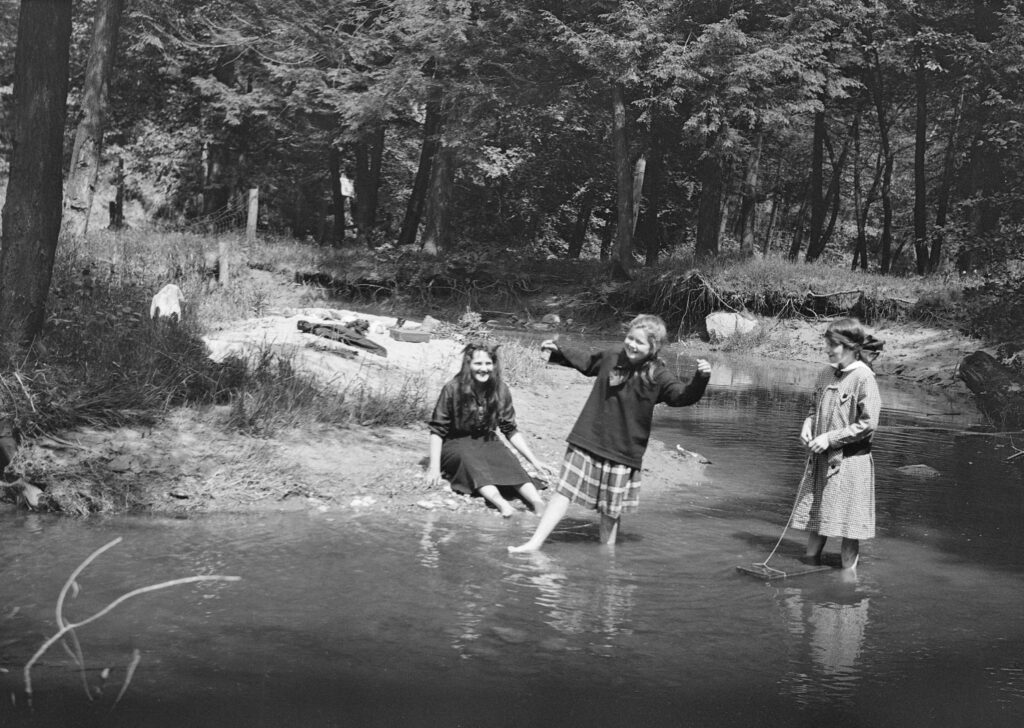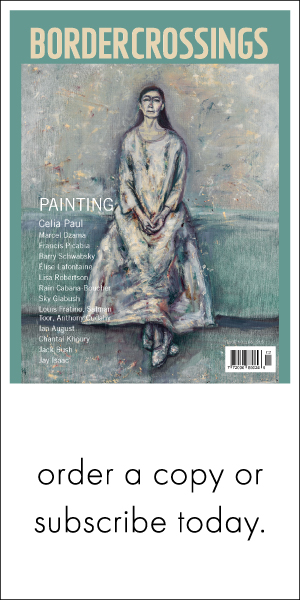Virtually every day for twenty years, I have walked my dog (more accurately, one of two successive dogs) around Wychwood Park in Toronto. This green oasis sits on the former shore of the prehistoric Lake Iroquois. Under a canopy of 300-year-old oaks, the air is fresher and cooler in summer, the wind less biting in winter. Birdsong provides a constant symphony, and before the trees are fully leafed in, you can see migrant warblers as well as the resident red-tailed hawks tending their eyases on the west side of the pond.
Since the hawks built their lofty residence a few years ago, mallards no longer brood nearby as they once did — their fluffy little offspring being tempting snacks — but they often visit in late summer or fall when the ducklings have reached the size of their parents. There used to be plenty of fish breaking the water to catch insects, but one sad summer a voracious cormorant ate most of them; the painted turtles mysteriously disappeared about the same time. Other regulars include rabbits and, increasingly these days, coyotes. The more there are of the former, the more there are of the latter.
My neighbourhood of around 14,500 people, many of them renters and new Canadians, is named Wychwood, after this private but still publicly accessible enclave at the heart of it. And at the centre of Wychwood Park itself sits the pond, my favourite place. The pond was created in the 1880s by damming Taddle Creek, which used to run through Wychwood Park and now runs under it. The creek was stopped up partly for aesthetic purposes and partly to supply ice to the surrounding houses. No one knows where its headwaters are, but they are suspected to be just north of here.

Wading through the history and promise of a unique Toronto neighbourhood.
John Boyd, 1916; Library and Archives Canada
Taddle Creek may be seen exiting briefly on the south side of the road that circles the pond — a rare above-ground appearance these days. From there, the water disappears once more into a culvert, only to be heard burbling under manhole covers by those who listen carefully. From time to time, it reminds citizens of its hidden presence by flooding their basements. On its southward journey to Lake Ontario, Taddle Creek carved the ravine on the University of Toronto campus now known as Philosopher’s Walk; it was once dammed just south of there as well, to make McCaul’s Pond. Although much loved by nineteenth-century students for fishing, skating, and occasional swimming, the pond became so polluted by sewage that it had to be drained in 1884. Construction of Hart House would begin there in 1911.
I am very glad that my precious pond did not endure the same fate as McCaul’s. On the contrary: in the 1990s, locals raised $90,000 to dredge it and restore its health. These days, whenever the pond becomes choked with duckweed and threatens to turn into a malodorous swamp, Wychwood Park’s aged caretaker can be seen skimming the surface with a net, attempting, somewhat ineffectually, to clean it. He also has a little boat moored there, though for what purpose no one knows as he has never been seen rowing it. One sign affixed to the fence skirting the pond warns passersby to be wary of deep water and quicksand; another announces that a small opening in the barrier is actually a “Baby Goose Door.” In winter, after a good freeze, hockey nets come out, defying yet another notice warning skaters that they enjoy themselves at their peril.
Yes, the place is almost unbearably twee, and I love everything about it. I love that it was named after Wychwood Forest in Oxfordshire, England, by a landscape painter with a fabulous name who had grown up there. Born in 1837, Marmaduke Matthews acquired a ten-acre wooded property — then outside Toronto city limits — in the 1870s, hoping to start an artists’ colony. He built his own house at number 6 in 1874 and populated it with eight human residents and a dog; a horse and a cow lived outside, where he possessed two acres of orchard and gardens and one of swamp. He soon realized that few other painters were similarly prosperous (he regularly painted the prairies and the Rockies for the Canadian Pacific Railway), so he invited Alexander Jardine, owner of the Pure Gold Manufacturing Company, to help him develop the site. In 1877, Matthews and Jardine bought an adjacent twelve acres, and Jardine built his own home, Braemore, now number 22. Jardine’s personal spread measured ten acres and included six humans, one dog, one horse, one cow, and three acres of orchards. The York Township assessment rolls of 1881 value Matthews’s property at $4,000 and Jardine’s at $5,000. They now owned all the land from Davenport Road to St. Clair Avenue West, between Bathurst and Christie Streets.
Matthews and Jardine filed a plan of subdivision in 1888, providing for eighteen large lots: seventeen for building and one for parkland. In 1891, the plan was revised to include thirty-eight smaller lots and to add building restrictions (for example, there were to be no commercial activities and no row houses). This made Wychwood Park one of the first planned communities in Canada. Many of its Arts and Crafts homes, boasting Tudor half-timbering, leaded glass windows, and huge fireplaces, were designed by Eden Smith, the prolific Canadian architect, who himself occupied number 5. All later homes were supposed to complement Smith’s designs, though the trustees’ insistence on maintaining the “spirit” of the place has caused a lot of friction over the years as the land became at once more subdivided and more expensive.
Determined to control the development of their little utopia, Matthews and Jardine also registered a four-page trust deed, which includes a method of calculating an annual private levy, based on lot size and exclusive of buildings, to be spent on maintaining the circular road and the common land. The same method is still used today, to the chagrin of residents, especially those whose homes front on Alcina Avenue on the northern edge of the enclave and who therefore do not often use the private road they are nonetheless expected to pay for. These restrictions have occasionally caused matters to become so heated that people have moved away. But the biggest scandal was the suicide in 2008 of the long-time resident Albert Fulton, a retired mathematics teacher who was the devoted archivist of the place and a member of the Neighbourhood Watch. When he was exposed as the culprit who had slashed the tires of a car that habitually parked on the road, thus enraging him, he drowned himself in Lake Ontario.
In 2015, I published a novel about an imaginary murder in Wychwood Park. I hadn’t yet heard about the suicide; nor was I familiar with the general history of the place. It was just the route of my daily walking meditation avec chien. On one such ramble, my otherwise obedient companion, Toby, started barking frantically before jerking his leash out of my hand and taking off into the bushes. Undoubtedly I had read too many murder mysteries, because my immediate thought was “I hope he doesn’t find a dead body.” That notion inspired Safe as Houses, which mostly investigates how fragile our sense of security really is but also alludes to the outrageous price of Toronto real estate. Things have only escalated since then, bringing the cost of a first home beyond the budget of most young people, including my own two.
Luckily for Alice Matthews, she inherited her father’s beautiful house, living in it until 1960. Marmaduke himself died in 1913; he is also remembered today as a founding member of both the Ontario Society of Artists and the Royal Canadian Academy. In 1985, Wychwood Park received a heritage designation under the Ontario Heritage Act because of its uniqueness, described as “a landscape with houses set into it” and “far more than the sum of its buildings.”
“A landscape with houses set into it” ought to be the description of any human settlement: reciprocity between nature and culture is essential if we are to avoid catastrophe both locally and globally. Wychwood Park is a tiny example of how a place can evolve over time without entirely suppressing its ecology; how it can sustain indigenous plants and animals around a built environment and accommodate them all. I know the place is stupidly expensive (at this writing, in summer 2024, three of its sixty homes are for sale: number 12 is listed at $3,800,000; number 17 at $6,850,000; and number 88 at $6,895,000) and is therefore in no way a model for municipal housing. But I don’t walk there every day to admire rich people’s domiciles; I walk there to see the seasons change and the flora and fauna change with them. I walk there to clear my head of mundane troubles and to breathe in, and be breathed by, some of the oldest oaks and white pines in my overbuilt city.
Virginia bluebells and daffodils have naturalized themselves everywhere in Wychwood Park, as have blackberries and flowering raspberries. Baltimore orioles visit in the spring, and herons arrive in late summer, while black-capped chickadees sing their wee hearts out all winter. No matter how noisy and busy and choked with traffic fumes the rest of Toronto is, when I do my daily circuit around the pond, I can imagine a better world.
Susan Glickman is a poet and novelist. She walks her dog, Virginia Woof, around Wychwood Park in Toronto every day.

